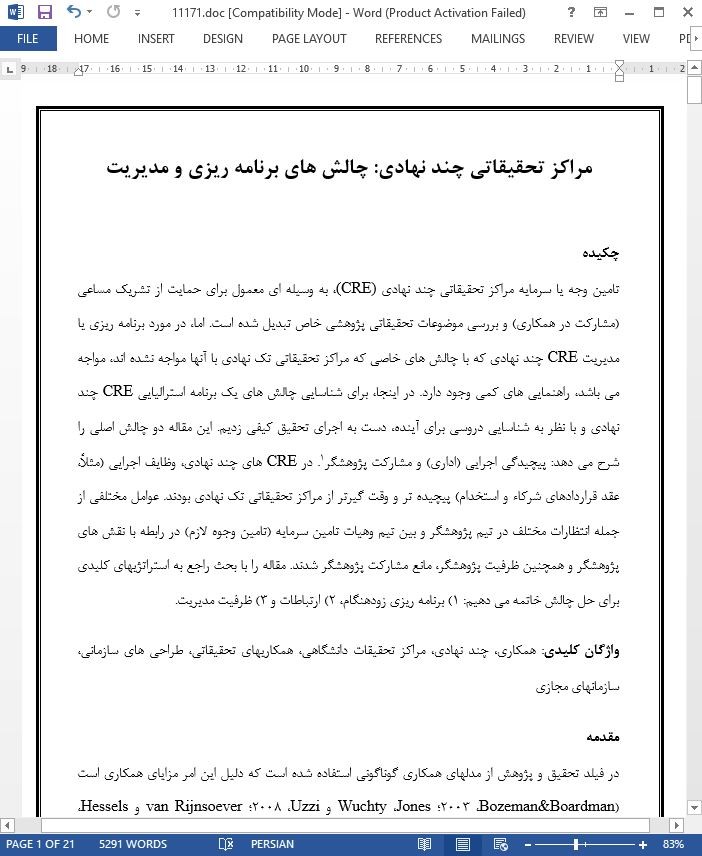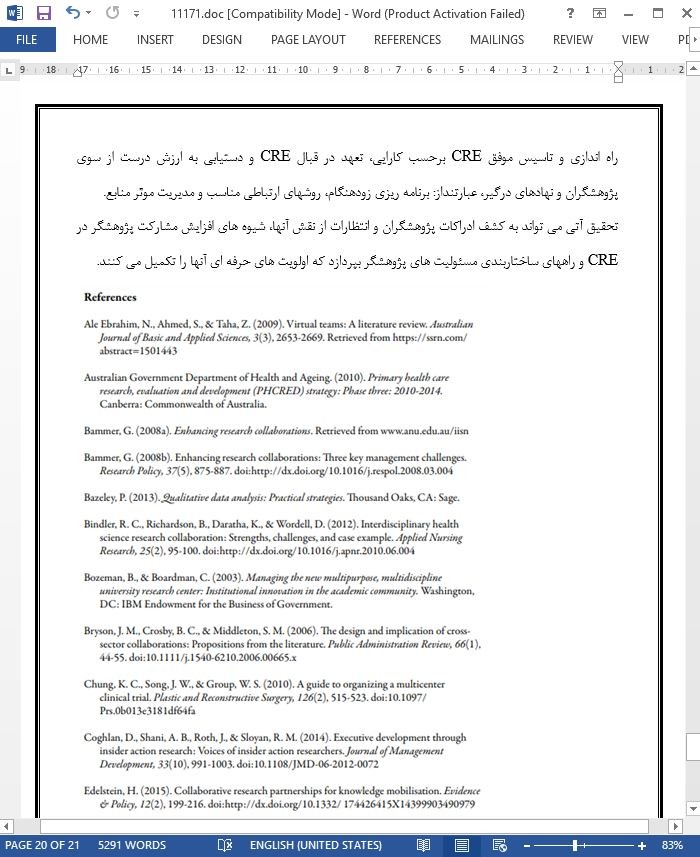
مراکز تحقیقاتی چند نهادی: چالش های برنامه ریزی و مدیریت
چکیده
تامین وجه یا سرمایه مراکز تحقیقاتی چند نهادی (CRE)، به وسیله ای معمول برای حمایت از تشریک مساعی (مشارکت در همکاری) و بررسی موضوعات تحقیقاتی پژوهشی خاص تبدیل شده است. اما، در مورد برنامه ریزی یا مدیریت CRE چند نهادی که با چالش های خاصی که مراکز تحقیقاتی تک نهادی با آنها مواجه نشده اند، مواجه می باشد، راهنمایی های کمی وجود دارد. در اینجا، برای شناسایی چالش های یک برنامه استرالیایی CRE چند نهادی و با نظر به شناسایی دروسی برای آینده، دست به اجرای تحقیق کیفی زدیم. این مقاله دو چالش اصلی را شرح می دهد: پیچیدگی اجرایی (اداری) و مشارکت پژوهشگر . در CRE های چند نهادی، وظایف اجرایی (مثلاً، عقد قراردادهای شرکاء و استخدام) پیچیده تر و وقت گیرتر از مراکز تحقیقاتی تک نهادی بودند. عوامل مختلفی از جمله انتظارات مختلف در تیم پژوهشگر و بین تیم وهیات تامین سرمایه (تامین وجوه لازم) در رابطه با نقش های پژوهشگر و همچنین ظرفیت پژوهشگر، مانع مشارکت پژوهشگر شدند. مقاله را با بحث راجع به استراتژیهای کلیدی برای حل چالش خاتمه می دهیم: 1) برنامه ریزی زودهنگام، 2) ارتباطات و 3) ظرفیت مدیریت.
مقدمه
در فیلد تحقیق و پژوهش از مدلهای همکاری گوناگونی استفاده شده است که دلیل این امر مزایای همکاری است (Bozeman&Boardman، 2003؛ Jones، Wuchty و Uzzi، 2008؛ van Rijnsoever و Hessels، 2011؛ Wuchty، Jones، و Uzzi، 2007). مدل پیشنهادی از محققین و افراد یا سازمانهایی تشکیل می شود که از تحقیق استفاده کرده یا متاثر از آن واقع می شوند ( مثلاٌ جوامع، سیاست گذاران و فراهم کنندگان سلامت). در چنین مواردی، هدف همکاری، افزایش سودمندی و امکان سنجی (شدنی بودن) تحقیق، و افزایش احتمال پیاده سازی تحقیق است (Edelstein، 2015). مدل مذکور از محققینی تشکیل می شود که به طرقی از جمله پیشینه رشته ای، تجربه و یا مکان تحقیق با یکدیگر تفاوت دارند. این مسئله می تواند رویکردهای بین رشته ای برای مسائل پیچیده فراهم نموده، گستره جغرافیایی سایت ها و شبکه های جمع آوری داده ها را وسعت بخشیده، و دامنه و عمق تجربه تحقیق پروژه را افزایش دهد (Bindler، Richardson، Daratha و Wordell، 2012؛ Wagner و همکاران، 2011).
نتیجه گیری
این مطالعه، برخی از چالش های سخت و غیرعادی مشاهده شده در هنگام تاسیس و مدیریت CRE را روشن نمود.
بسیاری از چالش ها ریشه در نیاز به تطبیق نیازهای پژوهشگران متعدد، نهادهای متعددی که در سایت های متعدد گسترش یافتند و همچنین رابطه سازی و حس تیم بودن در ساختار سازمانی پیچیده داشتند. عوامل ضروری برای راه اندازی و تاسیس موفق CRE برحسب کارایی، تعهد در قبال CRE و دستیابی به ارزش درست از سوی پژوهشگران و نهادهای درگیر، عبارتنداز: برنامه ریزی زودهنگام، روشهای ارتباطی مناسب و مدیریت موثر منابع.
تحقیق آتی می تواند به کشف ادراکات پژوهشگران و انتظارات از نقش آنها، شیوه های افزایش مشارکت پژوهشگر در CRE و راههای ساختاربندی مسئولیت های پژوهشگر بپردازد که اولویت های حرفه ای آنها را تکمیل می کنند.
Abstract
Funding multi-institution centers of research excellence (CREs) has become a common means of supporting collaborative partnerships to address specific research topics. However, there is little guidance for those planning or managing a multi-institution CRE, which faces specific challenges not faced by single-institution research centers. We conducted qualitative research to identify the challenges faced by an Australian program of multiinstitution CREs with a view to identifying lessons for the future. This paper describes two of the most significant challenges: administrative complexity and investigator engagement. Administrative tasks (e.g.: establishing partner contracts and recruitment) were significantly more complex and time-consuming in the multi-institution CREs than single-institution research centers. Investigator engagement was hampered by a range of factors, including differing expectations within the investigator team and between the team and the funding body in relation to investigator roles as well as investigator capacity. We conclude with a discussion of key strategies that cut across the challenges: 1) early planning, 2) communication and 3) management capacity.
Introduction
A range of collaborative models is increasingly used in the research field because of the benefits collaboration can provide (Bozeman & Boardman, 2003; Jones, Wuchty, & Uzzi, 2008; van Rijnsoever & Hessels, 2011; Wuchty, Jones, & Uzzi, 2007). The model might include researchers and people or organizations that might use or be affected by the research (e.g. communities, policy makers, health providers). In such cases, collaboration aims to increase the appropriateness and feasibility of research, and to increase the likelihood that the research will be implemented (Edelstein, 2015). The model might include researchers that differ in some way to each other, for example, in disciplinary background, research experience and/or location. This can provide interdisciplinary perspectives to complex problems, broaden the geographic spread of data collection sites and networks, and increase the range and depth of research experience brought to the project (Bindler, Richardson, Daratha, & Wordell, 2012; Wagner et al., 2011).
Conclusion
This study highlighted some of the highly demanding and unusual challenges that can be encountered during the establishment and management of a CRE.
Many of the challenges stemmed from the requirement to accommodate the needs of multiple investigators, in multiple institutions that were spread across multiple sites, and to build relationships and a ‘sense of team’ within a complex organizational structure. Early planning, appropriate communication methods, and effective management of resources are necessary for the successful operation of CREs in terms of efficiency, building commitment to the CRE, and getting true value from the investigators and institutions involved.
Further research could explore investigators perceptions and expectations of their role, approaches to increase investigator engagement in the CRE, and ways to structure investigator responsibilities that complement their career priorities.
چکیده
مقدمه
روش
طرح
وضوح و شفافیت اصول اخلاقی
استراتژی نمونه گیری
فرایند استخدام
نمونه
ابزار جمع آوری داده ها
جمع آوری داده ها
تحلیل داده ها
یافته ها
پیچیدگی اجرایی
قراردادهای شرکاء
استخدام در CRE
مشارکت پژوهشگر
بحث
برنامه ریزی زودهنگام
ارتباطات
ظرفیت مدیریت
نتیجه گیری
Abstract
Introduction
Method
Design
Ethics Clearance
Sampling Strategy
The Recruitment Process
Sample
Data Collection Instrument
Data Collection
Data Analysis
Findings
Administrative Complexity
Partner Contracts
Recruitment Across the CREs
Investigator Engagement
Discussion
Communication
Management Capacity
Conclusion
- اصل مقاله انگلیسی با فرمت ورد (word) با قابلیت ویرایش
- ترجمه فارسی مقاله با فرمت ورد (word) با قابلیت ویرایش، بدون آرم سایت ای ترجمه
- ترجمه فارسی مقاله با فرمت pdf، بدون آرم سایت ای ترجمه



